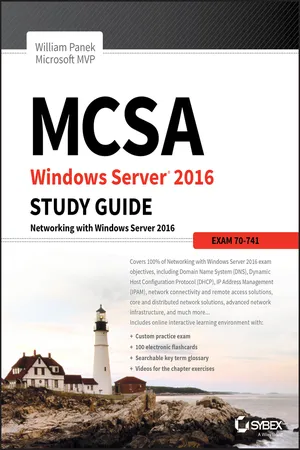
- English
- ePUB (mobile friendly)
- Available on iOS & Android
MCSA Windows Server 2016 Study Guide: Exam 70-741
About this book
Ultimate coverage and hands-on practice for the second MCSA Windows Server 2016 exam
MCSA Windows Server 2016 Study Guide: Exam 70-741 offers complete preparation for the second exam in the MCSA series. With comprehensive coverage of all exam objectives led by a four-time Microsoft MVP winner, this book is your ideal companion for thorough preparation. Optimize your study time with hundreds of practice questions that pinpoint your weak spots, and try your hand at real-world application with exercises that reflect the MCSA skill set. Access to the Sybex interactive online practice test environment provides electronic flashcards, a glossary, practice exams and more, so you can study anywhere, any time; this invaluable study guide goes beyond mere review to help you enter the exam with full confidence in your abilities.
The Microsoft Certified Solutions Associate certification puts your skills in demand—but first you must pass a series of three exams; exam 70-741 is the second step, testing your Windows 2016 networking knowledge and skills. This book covers everything you need to know, giving you the exam-day advantage of comprehensive prep.
- Master 100 percent of the exam objective domains
- Learn how these skills are applied in real-world scenarios
- Solidify your understanding with hands-on exercises
- Access electronic flashcards, practice exams, and more!
How well do you deploy, manage, and maintain a server? Can you expertly configure file and print servers, network access and services, and network policy server infrastructure? Have you configured and managed Active Directory and Group Policy? Don't leave anything to chance— MCSA Windows Server 2016 Study Guide: Exam 70-741 tells you all you need to know to pass with flying colors.
Frequently asked questions
- Essential is ideal for learners and professionals who enjoy exploring a wide range of subjects. Access the Essential Library with 800,000+ trusted titles and best-sellers across business, personal growth, and the humanities. Includes unlimited reading time and Standard Read Aloud voice.
- Complete: Perfect for advanced learners and researchers needing full, unrestricted access. Unlock 1.4M+ books across hundreds of subjects, including academic and specialized titles. The Complete Plan also includes advanced features like Premium Read Aloud and Research Assistant.
Please note we cannot support devices running on iOS 13 and Android 7 or earlier. Learn more about using the app.
Information
Chapter 1
Configuring TCP/IP
- Configure IPv4 and IPv6 addressing

- Configure IP address options
- Configure IPv4 or IPv6 subnetting
- Configure supernetting
- Configure interoperability between IPv4 and IPv6
- Configure ISATAP
- Configure Teredo

Understanding TCP/IP
Details of the TCP/IP Model

How TCP/IP Layers Communicate

Understanding Port Numbers
Table of contents
- Cover
- Title Page
- Copyright
- Dedication
- Acknowledgments
- About the Authors
- Introduction
- Assessment Test
- Chapter 1 Configuring TCP/IP
- Chapter 2 Configuring DNS
- Chapter 3 Configuring DHCP
- Chapter 4 Implement IP Address Management
- Chapter 5 Configuring Network Access
- Chapter 6 Understanding File Services
- Chapter 7 Configuring High Availability
- Chapter 8 Implementing Software Defined Networking
- Appendix Answers to the Review Questions
- Advert
- EULA